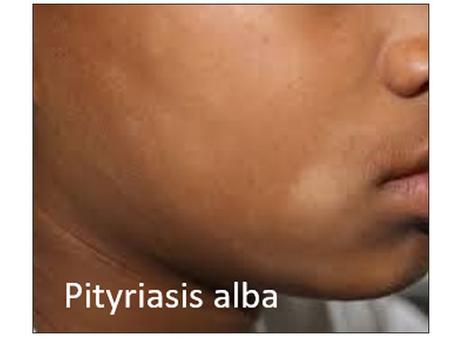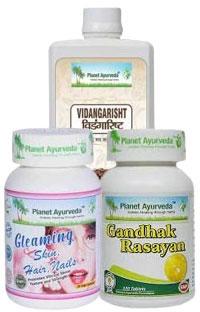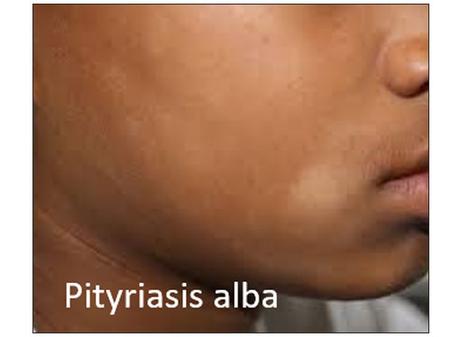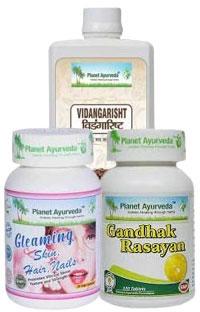Abstract
Pityriasis alba is a common, benign skin condition that primarily affects children and teenagers. It is characterized by round or oval, hypopigmented lesions with thin scales. Pityriasis alba may be a mild symptom of atopic dermatitis, and most patients have a history of atopy. The lesions may be slightly erythematous at first, then turn hypopigmented with time. Those with darker skin types tend to notice them more, and they are most frequently found on the face, arms, and upper trunk. The lesions become more noticeable in the sun. In this article, we discuss pityriasis alba in detail.

Introduction
Pityriasis alba is a common, benign skin condition that primarily affects young people. Its name describes how it looks: alba denotes its pale hue (hypopigmentation), and pityriasis alludes to its thin scales. Pityriasis alba may be a mild symptom of atopic dermatitis, and most patients have a history of atopy. It is typified by round or oval, poorly defined macules and patches (or thin plaques), frequently with minor scaling, and occasionally with mild pruritus. The lesions may be slightly erythematous at first, then they gradually turn hypopigmented. They are more prominent in those with darker skin types and are more frequently found on the face, arms, and upper trunk, particularly the cheeks. The lesions become more noticeable in the sun. Parents and patients frequently worry about how the lesions will look cosmetically. The spontaneous resolution of Pityriasis alba results in a gradual restoration of normal skin pigmentation.
Causes
Pityriasis alba's precise cause is unknown. Nonetheless, it's frequently thought of as a mild variant of atopic dermatitis, which is a sort of eczema. An hyperactive immune system that reacts angrily to stimuli may be the cause of eczema. The protective function of the skin is diminished in eczema sufferers. Normally, the immune system exclusively targets the proteins of dangerous entities like bacteria and viruses, ignoring benign proteins. But if you have eczema, your immune system can not always know the difference and end up attacking your body's good chemicals. It aggravates the irritation. It is comparable to an allergic reaction. Pityriasis alba and eczema typically go away by early adulthood.
Symptoms
Pityriasis alba causes areas of light pink or red skin that are shaped like circles, ovals, or other irregular shapes. Usually, the areas are dry and scaly. They could show up on the
- Face, the most frequent location
- Upper arms, back, neck, and chest
After a few weeks, light-coloured patches may replace the pale pink or red blotches. These lesions usually disappear within a few months, although sometimes they might linger for years. They are particularly noticeable in the summer when the surrounding skin tans. This explains why the pityriasis patches don't tan. If you wear sunscreen in the summer, the patches might be less noticeable. Darker skin tones also make the light regions more noticeable.
Diagnosis
Pityriasis alba is often diagnosed by a clinical exam. However, it can be mistaken for a number of other conditions that result in hypopigmentation. Investigations may involve the following to rule these out
- Wood lamp examination
- Scrapings for mycology
- Skin biopsy
Management
Without treatment, pityriasis alba frequently improves, but it could take some time. Normal skin pigmentation may not return for several months or even years. But the majority of people's skin heals in a year or less.
To alleviate the symptoms, people can do the following
- Try using moisturizing agents.
- Consult a physician about the use of topical medications: Nonsteroidal creams such as crisaborole (Eucrisa), tacrolimus (Protopic), and pimecrolimus (Elidel) may lessen itching related to pityriasis alba
- Try topical steroids with low potency.
Ayurvedic View
In Ayurveda, Pityriasis alba is correlated with Mandala kustha. It is one type of kustha. Skin conditions of various kinds are referred to as kustha. There are three doshas involved in this, and each is treated in accordance with its symptoms. Kapha dosha vitiation is a factor in mandala kusth.
Mandala Kushta
श्वेतं रक्तं स्थिरं स्त्यानं स्निगधंमुत्स्नंमण्डलं |
कृच्छ्रमन्योन्यसंसक्तं कुष्ठ्म मंडलमुच्यते || (च चि ७/१६ )
Acharya Charak describes Mandala kustha (Pityriasis alba) as the production of round, circular patches that are white, red, extensive, stable, unctuous, and linked with each other. It is not very treatable.
Causes Of Mandala Kustha
- Unctuous and dense materials.
- Repress your instincts.
- Take incompatible foods and beverages on a regular basis.
- Exposed to extreme heat following a heavy meal.
- Exertion.
- Exposed to physical activity.
- Use cold water immediately following an extended period of sun exposure.
- Fear.
- Eat when experiencing dyspepsia.
- Utilize goods that are not recommended during panchakarma therapy.
- Get regular daytime sleep.
- Overindulgence in fish, curd, salty, and sour foods.
- Having sex whilst suffering from dyspepsia.
Lakshanas/ Symptoms
- Redness
- Scaling
- Itching
- Fever
- Sore throat
- Headache, and scaled patch.
Herbal Remedies For Pityriasis Alba By Planet Ayurveda
The special herbal formulations from Planet Ayurveda can help you ease the symptoms of sarcopenia and cure it miraculously by balancing the vata dosha and promoting mamsa vridhi. Planet Ayurveda uses four herbal formulations-vikramprash, shatavari ghrita, weight gain pills, and Ashwagandha capsules-to treat sarcopenia. These formulas are all made under the appropriate guidance of M.D. Ayurvedic professionals. Formulations are entirely natural, devoid of artificial ingredients such as gums, starches, resins, fibers, etc. or preservatives.
Product List
- Gandhak Rasayan
- Vidangarisht
- Gleaming Skin, Hair, Nails Formula


Product Description
1. Gandhak Rasayan
With the use of shuddha gandhak (purified sulfur), Planet Ayurveda created Gandhak rasayan, a single herbal tablet. For skin conditions, it is advantageous. It reduces redness and itching. It soothes the three doshas, pitta, kapha, and vata. Furthermore, it purifies the blood, which helps with skin condition rehabilitation. It fights several kinds of allergies. It regulates the immune system and possesses antimicrobial properties. Urinary tract infections, blood problems, and skin diseases can all benefit substantially from it. Aging symptoms are slowed by it. There is a reduction in macules.
Dosage : Take two tablets twice daily with plain water after a meal.
2. Vidangarisht
With the aid of Vaividang (Embelia ribes), Holarrhena antidysenterica (Kutaj), Lodhra (Symplocos racemosa), and a few more components, Planet Ayurveda created Vidangarisht, a multi-herbal concoction. Vidangarishta is vital for treating many infections and skin ailments. This polyherbal mixture's high antioxidant content effectively eliminates harmful free radicals from the body, and its antipruritic qualities lessen itching caused by allergic conditions including sunburn, eczema, psoriasis, scabies, patchy skin, etc.
Dosage : Take two teaspoons twice daily after a meal with plain water.
3. Gleaming Skin, Hair, Nails Formula
Planet Ayurveda created the multi herbal capsule known as Gleaming Skin, Hair, and Nails Formula by combining Manjistha (Rubia cordifolia), Fumaria officinalis (Pitpapda), Sariva (Hemidesmus indicus), and Aloe barbadensis (Ghritkumari). That appeases Pitta and Kapha. It helps treat recurrent skin disorders such as pigmentation irregularities and leucoderma. It improves complexion and functions as a detoxifier, hematopoietic system booster, and blood cleaner. In addition to improving the skin's sheen and brightness, it helps to clear up acne and discolouration. It also possesses restorative, antioxidant, anti-inflammatory, and rejuvenating qualities.
Dosage : Take one capsule twice daily after a meal with plain water.
Contact Planet Ayurveda Support Team to provide you the costing/ordering and delivery information at - [email protected] or Call at 0172-521-4040 (India), +91-172-521-4040 (Outside India) or Whatsapp at (+91) 842-749-4030. Conclusion
Commonly affecting children and adolescents, pityriasis alba is a benign skin disorder with characteristic round or oval hypopigmented lesions covered in thin scales. When the pinkness or redness has receded, pityriasis alba, a mild dermatitis or eczema, typically affects circular or oval forms and leaves behind pale (hypopigmented) patterns. It is not communicable and does not appear to have an infectious cause. Mandala kustha (Pityriasis alba), according to Acharya Charak, is the formation of circular, rounded patches that are white, red, extensive, stable, unctuous, and linked with one another. We covered pityriasis alba in this post, along with herbal treatments for the condition.
DR. Vikram Chauhan, MD - AYURVEDA is an expert ayurvedic doctor based in Chandigarh, India and doing his practice in Mohali, India. He is spreading the knowledge of Ayurveda - Ancient healing treatment, not only in India but also abroad. He is the CEO and Founder of Planet Ayurveda Products, Planet Ayurveda Clinic and Krishna Herbal Company. Write at - [email protected], Contact at - +91-172-521-4030 Websites - www.planetayurveda.com, www.alwaysayurveda.com
View more posts from this authorAbstract
Pityriasis alba is a common, benign skin condition that primarily affects children and teenagers. It is characterized by round or oval, hypopigmented lesions with thin scales. Pityriasis alba may be a mild symptom of atopic dermatitis, and most patients have a history of atopy. The lesions may be slightly erythematous at first, then turn hypopigmented with time. Those with darker skin types tend to notice them more, and they are most frequently found on the face, arms, and upper trunk. The lesions become more noticeable in the sun. In this article, we discuss pityriasis alba in detail.

Introduction
Pityriasis alba is a common, benign skin condition that primarily affects young people. Its name describes how it looks: alba denotes its pale hue (hypopigmentation), and pityriasis alludes to its thin scales. Pityriasis alba may be a mild symptom of atopic dermatitis, and most patients have a history of atopy. It is typified by round or oval, poorly defined macules and patches (or thin plaques), frequently with minor scaling, and occasionally with mild pruritus. The lesions may be slightly erythematous at first, then they gradually turn hypopigmented. They are more prominent in those with darker skin types and are more frequently found on the face, arms, and upper trunk, particularly the cheeks. The lesions become more noticeable in the sun. Parents and patients frequently worry about how the lesions will look cosmetically. The spontaneous resolution of Pityriasis alba results in a gradual restoration of normal skin pigmentation.
Causes
Pityriasis alba's precise cause is unknown. Nonetheless, it's frequently thought of as a mild variant of atopic dermatitis, which is a sort of eczema. An hyperactive immune system that reacts angrily to stimuli may be the cause of eczema. The protective function of the skin is diminished in eczema sufferers. Normally, the immune system exclusively targets the proteins of dangerous entities like bacteria and viruses, ignoring benign proteins. But if you have eczema, your immune system can not always know the difference and end up attacking your body's good chemicals. It aggravates the irritation. It is comparable to an allergic reaction. Pityriasis alba and eczema typically go away by early adulthood.
Symptoms
Pityriasis alba causes areas of light pink or red skin that are shaped like circles, ovals, or other irregular shapes. Usually, the areas are dry and scaly. They could show up on the
- Face, the most frequent location
- Upper arms, back, neck, and chest
After a few weeks, light-coloured patches may replace the pale pink or red blotches. These lesions usually disappear within a few months, although sometimes they might linger for years. They are particularly noticeable in the summer when the surrounding skin tans. This explains why the pityriasis patches don't tan. If you wear sunscreen in the summer, the patches might be less noticeable. Darker skin tones also make the light regions more noticeable.
Diagnosis
Pityriasis alba is often diagnosed by a clinical exam. However, it can be mistaken for a number of other conditions that result in hypopigmentation. Investigations may involve the following to rule these out
- Wood lamp examination
- Scrapings for mycology
- Skin biopsy
Management
Without treatment, pityriasis alba frequently improves, but it could take some time. Normal skin pigmentation may not return for several months or even years. But the majority of people's skin heals in a year or less.
To alleviate the symptoms, people can do the following
- Try using moisturizing agents.
- Consult a physician about the use of topical medications: Nonsteroidal creams such as crisaborole (Eucrisa), tacrolimus (Protopic), and pimecrolimus (Elidel) may lessen itching related to pityriasis alba
- Try topical steroids with low potency.
Ayurvedic View
In Ayurveda, Pityriasis alba is correlated with Mandala kustha. It is one type of kustha. Skin conditions of various kinds are referred to as kustha. There are three doshas involved in this, and each is treated in accordance with its symptoms. Kapha dosha vitiation is a factor in mandala kusth.
Mandala Kushta
श्वेतं रक्तं स्थिरं स्त्यानं स्निगधंमुत्स्नंमण्डलं |
कृच्छ्रमन्योन्यसंसक्तं कुष्ठ्म मंडलमुच्यते || (च चि ७/१६ )
Acharya Charak describes Mandala kustha (Pityriasis alba) as the production of round, circular patches that are white, red, extensive, stable, unctuous, and linked with each other. It is not very treatable.
Causes Of Mandala Kustha
- Unctuous and dense materials.
- Repress your instincts.
- Take incompatible foods and beverages on a regular basis.
- Exposed to extreme heat following a heavy meal.
- Exertion.
- Exposed to physical activity.
- Use cold water immediately following an extended period of sun exposure.
- Fear.
- Eat when experiencing dyspepsia.
- Utilize goods that are not recommended during panchakarma therapy.
- Get regular daytime sleep.
- Overindulgence in fish, curd, salty, and sour foods.
- Having sex whilst suffering from dyspepsia.
Lakshanas/ Symptoms
- Redness
- Scaling
- Itching
- Fever
- Sore throat
- Headache, and scaled patch.
Herbal Remedies For Pityriasis Alba By Planet Ayurveda
The special herbal formulations from Planet Ayurveda can help you ease the symptoms of sarcopenia and cure it miraculously by balancing the vata dosha and promoting mamsa vridhi. Planet Ayurveda uses four herbal formulations-vikramprash, shatavari ghrita, weight gain pills, and Ashwagandha capsules-to treat sarcopenia. These formulas are all made under the appropriate guidance of M.D. Ayurvedic professionals. Formulations are entirely natural, devoid of artificial ingredients such as gums, starches, resins, fibers, etc. or preservatives.
Product List
- Gandhak Rasayan
- Vidangarisht
- Gleaming Skin, Hair, Nails Formula


Product Description
1. Gandhak Rasayan
With the use of shuddha gandhak (purified sulfur), Planet Ayurveda created Gandhak rasayan, a single herbal tablet. For skin conditions, it is advantageous. It reduces redness and itching. It soothes the three doshas, pitta, kapha, and vata. Furthermore, it purifies the blood, which helps with skin condition rehabilitation. It fights several kinds of allergies. It regulates the immune system and possesses antimicrobial properties. Urinary tract infections, blood problems, and skin diseases can all benefit substantially from it. Aging symptoms are slowed by it. There is a reduction in macules.
Dosage : Take two tablets twice daily with plain water after a meal.
2. Vidangarisht
With the aid of Vaividang (Embelia ribes), Holarrhena antidysenterica (Kutaj), Lodhra (Symplocos racemosa), and a few more components, Planet Ayurveda created Vidangarisht, a multi-herbal concoction. Vidangarishta is vital for treating many infections and skin ailments. This polyherbal mixture's high antioxidant content effectively eliminates harmful free radicals from the body, and its antipruritic qualities lessen itching caused by allergic conditions including sunburn, eczema, psoriasis, scabies, patchy skin, etc.
Dosage : Take two teaspoons twice daily after a meal with plain water.
3. Gleaming Skin, Hair, Nails Formula
Planet Ayurveda created the multi herbal capsule known as Gleaming Skin, Hair, and Nails Formula by combining Manjistha (Rubia cordifolia), Fumaria officinalis (Pitpapda), Sariva (Hemidesmus indicus), and Aloe barbadensis (Ghritkumari). That appeases Pitta and Kapha. It helps treat recurrent skin disorders such as pigmentation irregularities and leucoderma. It improves complexion and functions as a detoxifier, hematopoietic system booster, and blood cleaner. In addition to improving the skin's sheen and brightness, it helps to clear up acne and discolouration. It also possesses restorative, antioxidant, anti-inflammatory, and rejuvenating qualities.
Dosage : Take one capsule twice daily after a meal with plain water.
Contact Planet Ayurveda Support Team to provide you the costing/ordering and delivery information at - [email protected] or Call at 0172-521-4040 (India), +91-172-521-4040 (Outside India) or Whatsapp at (+91) 842-749-4030. Conclusion
Commonly affecting children and adolescents, pityriasis alba is a benign skin disorder with characteristic round or oval hypopigmented lesions covered in thin scales. When the pinkness or redness has receded, pityriasis alba, a mild dermatitis or eczema, typically affects circular or oval forms and leaves behind pale (hypopigmented) patterns. It is not communicable and does not appear to have an infectious cause. Mandala kustha (Pityriasis alba), according to Acharya Charak, is the formation of circular, rounded patches that are white, red, extensive, stable, unctuous, and linked with one another. We covered pityriasis alba in this post, along with herbal treatments for the condition.

